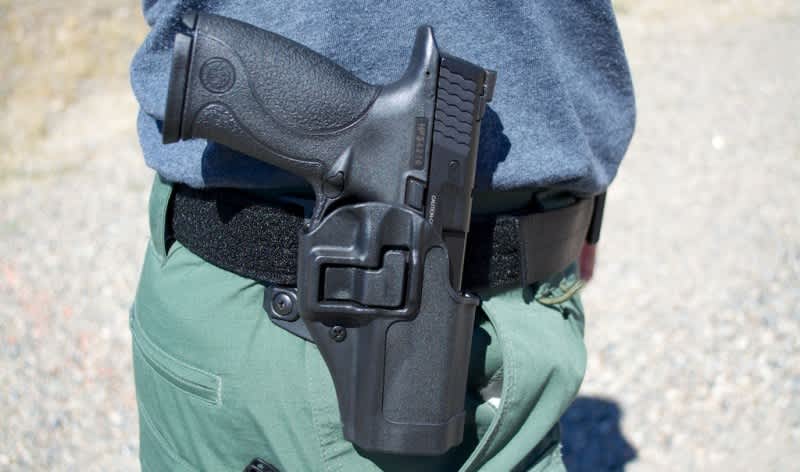The Seven Deadly Sins of Concealed Carry: Not Going Through the Motions
Tom McHale 12.26.13

Usually the phrase “going through the motions” carries a negative connotation—like feigning interest in hearing about Uncle Stanislaw’s commemorative spoon collection. Exciting as that may be, some of us would have to gen up a bit of enthusiasm to inspect his most recent purchase from the International Tea Set and Doily Museum.
When it comes to concealed carry, not going through the motions can be deadly.
What do I mean by going through the motions? The motions of practice! Practice drawing your concealed gun. Practice changing magazines. Practice clearing malfunctions.
Most people assume they will rise to the occasion with relatively simple and basic skills like drawing a gun, changing magazines, or clearing a jam. There’s a real easy way to disprove that notion. Enter a local shooting match; Steel Challenge, IDPA, or USPSA—it doesn’t really matter. The first time you have to perform an action under the stress of a clock running and crowd watching, you’ll most likely see how quickly you fall right back to the level of your most frequent practice—and that’s with an infinitesimal level of stress compared to any real armed encounter.
The first time you compete, I can almost guarantee you’ll mess up at least a little. Heck, in one of the training classes I took, the instructor was hollering at me (just for fun and to try to induce a little pressure while I was shooting) and I managed to dump a full magazine on the ground, eject two live cartridges and inadvertently engage the safety before getting off a successful shot. He and the rest of the class had a great laugh from that experience. It wasn’t unprofessional or malicious—just the opposite. I had been feeling kind of cocky because I was the guy shooting awesome groups at a whopping range of seven yards, so our opportunistic instructor saw a chance to teach us all a valuable lesson. By tormenting me, he showed the class how easy it is to revert to your lowest level of skill with only a little bit of induced stress.
Fortunately, developing some muscle and brain memory through practice is easy. And you can do it at home with your carry gun if you practice safe dry-fire procedures. After all, dry-firing is not as dirty as it sounds. Or, you can get fancy and invest in a practice gun like the SIRT training pistol. That’s money well spent as it provides visual feedback on where your practice shots hit.
Here are a few of the scenarios I like to practice in my home office and man cave.

Draw and evaluate
The most important part of draw practice at home, after observing ALL safe dry-fire procedures, is practicing with the exact type of clothing you wear when you carry. Practice with an exposed outside-the-waistband holster won’t do you much good if you’re an ankle or Flashbang bra holster carrier. Get used to sweeping your cover garment away, as appropriate to your holster choice, with every single draw motion until it becomes a habit. Experts say that you have to repeat an action 2,000 times for the movement to become habit. That sounds like a lot, but if you do 25 a day, it’s no big deal in the scope of life.
Draw and evaluate? Yes, evaluate. Remember how we talked about stress bringing out the lowest level of actual practice? There have been documented stories of police officers doing things like pocketing empty brass during shootouts with armed hoodlums, because that was their range practice regimen. I don’t believe you want to develop muscle and brain memory of pulling the trigger every time your draw your gun. After all, you may not need to shoot.
Draw and fire
Practice the full draw to shoot scenario too, because you might need that. By mixing draw and evaluate and draw and fire, you won’t be building a conditioned “fire every time” response.
Magazine changes
Here’s one we don’t always think about practicing while at the shooting range. Again, using safe dry-fire practices, start with your gun open and slide-locked, and pretend to fire a shot to simulate the magazine going empty. Now you can practice dumping your magazine to the floor and loading a new (empty) magazine. Make sure to complete the action by racking the slide to simulate loading a fresh cartridge.
Dry malfunctions
While you’re doing all this “normal operation” practice, why not practice the abnormal stuff too? While dry-firing, pretend there was no bang and go through a tap, rack, and evaluate sequence. You want to train your brain, eyes, and hands for that scenario too.
And the best way to practice running your concealed carry gun? Enter local shooting competitions! Such events won’t teach you beans about self-defense tactics, but they will teach you how to operate your gun under a little bit of stress. Granted, the stress of an audience, a running clock, and peer pressure is nothing like that of a life and death encounter, but it’s a start. Rather than optimize my rig, dress, and gun setup to “win” a Steel Challenge or IDPA match, I like to use my carry gun and carry clothes to get practice with the setup I use every day.
I might not beat those folks with Teflon rocket-assist holsters, one-pound triggers, and 47-round magazines, but I am getting valuable practice with the gear I bet my life on.

